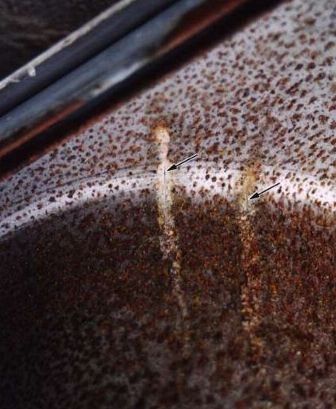
 |
Through various contacts I found that the house was not sited over any known toxic dump site. A neighbor advised the family that the house and three or four others in the subdivision had been flooded prior to being occupied. It's not clear whether inadequate freeze protection or copper tubing failure due to the get the lead out of solder problems were possibly involved or possible roof leaks. Also advised that the 3 year old's upstairs bedroom had to have the floor, rug and some wall board replaced due to the water damage.
Family noticed mold in the garage during a walk through prior to paper signing. Builder replaced some garage wall board near the twin water heaters due to the mold. Found evidence of a line leak or sweating problem in the utility room ceiling which caused noticeable bagging of the ceiling during my December visit. Builder replaced the affected ceiling area. The metal parts under the island sink were all corroded. I inspected all the other area's including bathrooms and the rest of the kitchen and could find no more corrosion. It appeared to be localized under the sink. The sink was properly vented. The flooring was vinyl not ceramic tile which seemed to minimize possible HCl grout cleanup exposure.
The corrosion on the ferrous metal parts basically looked like rust. The copper and brass were covered with a green deposit. I inventoried the cleaning materials the family stored under the sink and could find nothing that appeared very potent. Cleaners such as Comet had some bleach in it but nothing looked like it had leaked. All the materials were common household cleaners, not any industrial strength cleaners. Also noticed that even the steel cutting edge on plastic wrap and aluminum foil was corroded. An earlier roll of foil corroded and was thrown out. The corrosion on the cutting edges continued after the cleaners were moved to the garage. They had been replaced and only under the sink a couple of months.
Family advised that the builder agreed to replace the entire island cabinet and all the corroded metal parts including the sink. They replaced the cabinet, sink and metal parts before Christmas. I got together with the family in January and got samples of the cabinet which looked pristine on the bottom and sides, the sink and examples of the copper tubing and fittings as well as the hardware. I removed the cover plate from a double electrical receptacle under the sink to look at the copper wiring. It was pristine.
| The sink had pitting on both sides of the double basin. The most pitting was on the underside and was apparent on the bare stainless steel as well as under some material that was put on the bottom of the basins probably for sound deadening. There were also several apparent through wall cracks across the sink basin knuckles. |
|
 |
Some of the pitting was apparently through wall. Mounted samples verified that some of the pitting was through wall. The cracks and the pitting were due to intergranular and slip plane corrosion. The sink was type 301 stainless steel. Microstructurally, it was sensitized (carbides on the slip planes and in the grain boundaries). This was probably due to an interdraw stress relief in the roughly 1100 to 1600 F temperature range when the basins were being formed. EDX analysis showed the deposits in the pits to be mixed metal oxides and chlorides. The deposit on the copper/brass was copper chloride. |
After reviewing the overall situation, it appears that there is a reasonable possibility that the builder was concerned over a mold or potential mold problem as a result of the flooding problem. I suspect that a mold remediation company was called in and sprayed either bleach or some other chlorine containing disinfectant under the sink. The disinfectant or breakdown products combined with moisture caused the corrosion, which continued due the chloride/oxide/chloride cycle aided by the sound deadening retaining the corrodents. Although we have chlorides in the deposits we have not proved that it was caused by mold disinfectants.
I had advised the family in our first meeting in December that I felt they had a major health issue and to get some testing done. In March they had the air tested and found harmful mold in fairly high concentrations in the upstairs specifically in the 3 year old's bedroom and the playroom. It was recommended by the air testing company that they move out. They are currently living with parents. The kids breathing has improved somewhat in the month they have been out of the house. Since replacing the cabinet and sink no corrosion has been noted in the three plus months exposure on the foil/plastic wrap cutting edges or on the new sink. It would appear that this situation may be headed toward litigation.
I'd like to thank Bryant-Lee Associates from San Antonio for their metallographic and EDX deposit analysis work as well as everyone on the NACE corrosion network for their input.